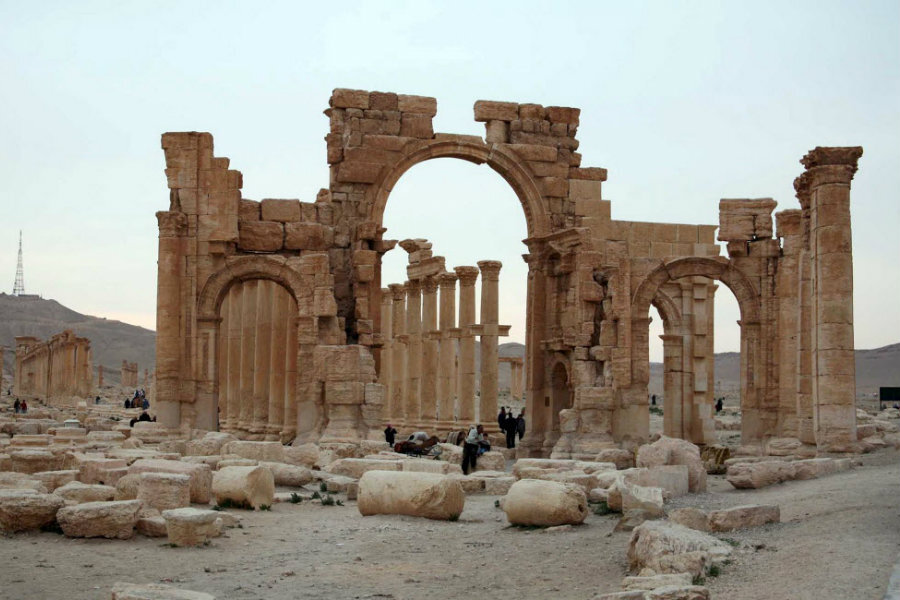On the field and online: How the fight against ISIS is a battle on two fronts
Loading...
For Islamic State fighters, the battle for dominance continues both on the ground and online: The extremists’ capture of the ancient Syrian site of Palmyra this week came with a Twitter-circulated photo of the group’s black flag flying over the city’s hilltop castle.
The militants’ decision to publicize their victory via social media is typical of the group’s strategy as it strives to use the Internet to push its propaganda forward – and it comes as the Obama administration faces increasing scrutiny of its policies for combating the extremist group on two fronts.
“A war of words continues, as both sides try to convince the world the momentum is in their favor,” national security reporter Paul D. Shinkman wrote for US News & World Report. “For the Islamic State group, it seems like yet another win.”
Indeed, the militants captured Palmyra – an ancient site that was “one of the most important cultural centres of the ancient world,” according to UNESCO – just days after they retook the Iraqi city of Ramadi, “undermining US assertions that the group is largely on the defensive after months of airstrikes by an international coalition,” The Washington Post reported.
The administration responded by casting the image of the fight as a long and arduous battle, even as it worked to keep its tone optimistic.
“No, I don’t think we’re losing,” President Obama told The Atlantic’s Jeffrey Goldberg in an interview shortly after ISIS took Ramadi. “There’s no doubt there was a tactical setback, although Ramadi had been vulnerable for a very long time, primarily because these are not Iraqi security forces that we have trained or reinforced.”
Away from the field, the State Department’s Center for Strategic Counterterrorism Communications (CSCC) has also faced criticism for its efforts at fighting the Islamic State, or ISIS, using the militant group’s online strategy.
The center’s video, “Welcome to ISIS Land,” sought to discredit the extremists and discourage would-be jihadists from joining the cause, and went viral as planned – but critics denounced its use of graphic imagery as “a disturbing embrace of the adversary's playbook,” the Houston Chronicle reported.
In addition, the State Department has not been able to determine whether or not the video had any impact on the flow of fighters to Syria, according to the Chronicle.
ISIS meanwhile continues to propagate an image of itself as a powerful, victorious, and growing organization. As Mr. Shinkman wrote:
The network’s propaganda arm has proven adept at disseminating reports that it thoroughly controls ground it has taken, like in Raqqa, Syria, considered the capital of its self-proclaimed caliphate, or Mosul, Iraq’s second-largest city now farther from the grasp of the U.S.-led coalition following the fall of Ramadi.
Still, experts say there are effective ways of combating ISIS. Among the most important is to stop exaggerating the group’s invincibility, Jessica Stern and J.M. Berger, authors of “ISIS: The State of Terror,” wrote for Time.
“ISIS relies on its projection of strength alongside the illusion of utopian domestic tranquillity,” they wrote. “When Western policymakers discuss ‘degrading’ ISIS, it should be in the context of forcing ISIS to make visible concessions in order to counter military pressure” – visible being the operative word.
“[O]ur targeting priorities should also aim to expose vulnerabilities for counterpropaganda purposes,” they added.
Such an approach appears to be on the agenda for the CSCC. Richard Stengel, a former Time managing editor hired by Secretary of State John Kerry to be head of public diplomacy, has advocated for more fact-based, and less snarky, messaging, according to the Chronicle.
“You say the caliphate is heaven on earth? We’re going to show you pictures where sewers don’t work,” Mr. Stengel told the paper. “You’re winning on the battlefield? Here’s a satellite picture of you guys retreating.”
How much of an impact such a shift will have in the propaganda war is yet to be determined. But whatever the US government’s policy is online will need to be bolstered by a corresponding strategy on the ground, The Atlantic's associate editor Kathy Gilsinan wrote in February.
“ISIS is surely a formidable force. Offline, the group is now estimated to be 30,000-strong or bigger,” she noted. “But the roots of its expansion probably don't lie on the virtual battlefield. More likely, they're on the real one.”








